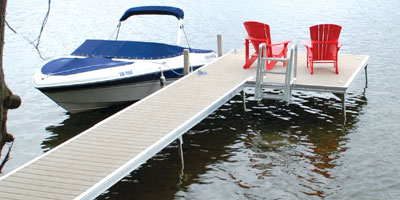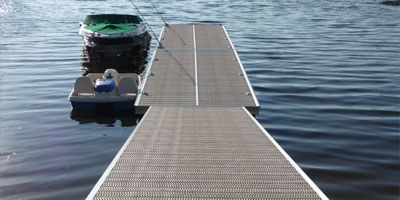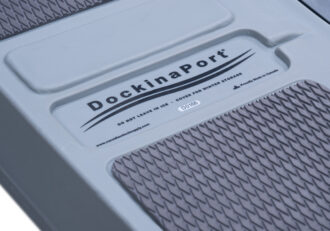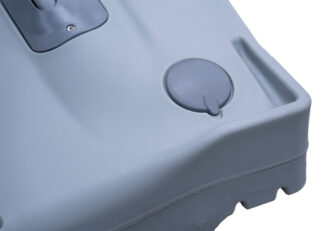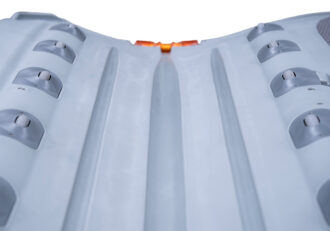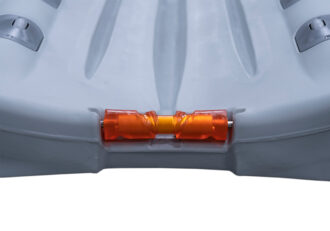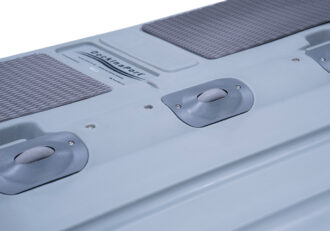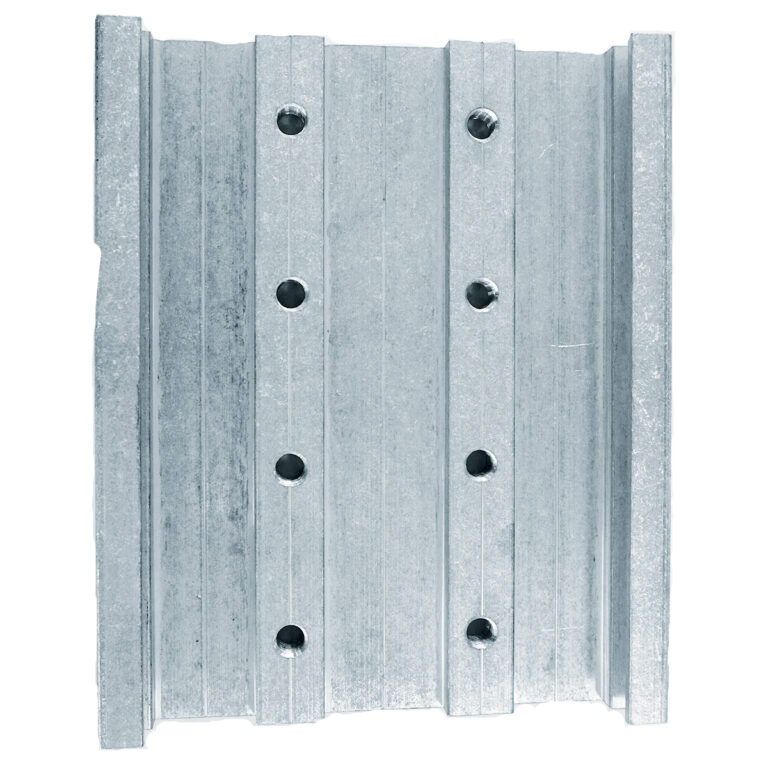
Features & Benefits
The DockinaPort® was designed and built to address the concerns about drive-on PWC ports that other manufacturers have not addressed. Many ports may only be about 130 inches long which is short if you want to put a cover on the longer PWC’s as there is not enough room to get around the back or run the risk of falling in the water.
Many of the smaller older port models may be fine for the smaller, older, or lighter watercraft but will limit you for many of the fuller sized PWC’s on the market today. With the emergence of the new lighter weight watercraft, many ports have too much buoyancy making it increasingly difficult to land your PWC and requiring too much speed to get out of the water. Less experienced riders have been known to overshoot the front end damaging the PWC and where the port is mounted.
Newer ports have small wheels which allow the heavier watercraft to roll much easier. The DockinaPort® has been purposely designed with a low profile, meaning the watercraft underbelly is just a few inches above the water. Driving on is just a matter of nosing up to the entry roller and lightly tapping the throttle. DockinaBox® also designed one of the biggest self-guiding bow-stops in the industry to go along with the ambidextrous ability to have the 13” wide side step walkway be located on either side of your PWC.








The Technology Behind Our Port
A unique characteristic of the DockinaPort® is that it is possible to adjust the floating height in the water specific to your individual needs. There are 6 strategically built independent buoyancy chambers located underneath the port. Two in the middle, two forward and two rear. These chambers have the ability to release or hold trapped air underneath the port. Removal of the air valve screw (and leaving it out) allows the trapped air to vent straight through to the atmosphere (this vent does not let the air within the DockinaPort® escape, just what is underneath). Because all PWC’s are not the same, these chambers give you the ability to adjust the attitude of the port in multiple ways. For example, if you have one of the newer heavier machines (800 to1000 lbs.) you can leave all the air valve screws closed in the 6 chambers and the height sits just right in the water. If you change watercraft or want to put one of the lighter 500lb PWC’s on the port, you can take out (remove) the valve from one or all 6 of the chambers and lower the entire port down in the water level (or only lower the section you want). Each of these chambers holds approximately 50 lbs. of trapped air. By removing the air valve screws it is possible to drop the buoyancy in that area, effectively lowering, tilting or custom adjusting the angle to your liking or needs. If you find you would like the watercraft to slide off the port more easily you would take out the air valve screw at each side of the rear allowing the port to sit lower in the water at the back. Putting the air back is just a simple matter of sliding the watercraft off the port applying some silicone or caulking on the threads of the air valve screws and, inserting it back in the hole.
Some of the new or lighter PWC’s are not very long. If you dock a 9 ft watercraft on the port and pull it up to the front you may find that it tips the front down and the back sticks up. This is a typical situation with any type of floating structure, i.e., if you stand on the end of a 4ft floating dock the end tips down into the water and the other end comes up. With other port models on the market, you are then stuck with this situation and there is nothing you can do about it. Sometimes what the boater will end up doing is moving the PWC to the middle of the port in order to balance the watercraft. But you then run the risk of the craft rolling off when not attended. With DockinaPort® you simply let the air out of the chamber you want to adjust.
Many drive-on PWC ports on the market are approx. 58 in wide and only about 130 inches long. Docking a larger 3 seat PWC on this type of port may have the stern protrude over the back which is also not desirable. From the sideview this doesn’t look good, and you run the risk of the watercraft rolling off in a slight wave. As mentioned earlier, the ability to adjust the DockinaPort® with the 6 independent floatation chambers along with the overall length our port, means we can address all the various size watercraft on the market today.
Mounting the port to a dock
Mounting the port to a dock is usually done in one of two ways and will depend on if you are mounting to a floating or fixed dock or structure.
A fixed dock or structure will use a pole mount to adjust to the rise and fall of the water level or any wake that may hit the port. A belt mount is conducive to a floating dock as the port would ride up and down with its attachment point on the floating dock system. Both attachment methods can be used at the front or side of the port. The pole mount is made in two lengths; the most common is 31inches of travel or height, and we also have the taller version offering 45inches of travel or height. With the DockinaBox® quick disconnect brackets you can attach either the pole mount or belt mount to your dock. This is a popular feature as it allows easy spring/fall removal of your DockinaPort® leaving only the side plate attached to the dock.
Most residential floating docks are between 12’’ and 18” above the water therefore the belt mount is designed specific to this application. As the water level changes, the belt maintains the position of the port beside the dock. The belt mount can also be attached to the DockinaBox® quick disconnect bracket that stays on the dock year-round. This eliminates the need to take apart the dock or get into the water to unscrew bolts from the back side or under the dock. The belt mount is mounted to the dock so when the watercraft is not on the port the belt is horizontal.
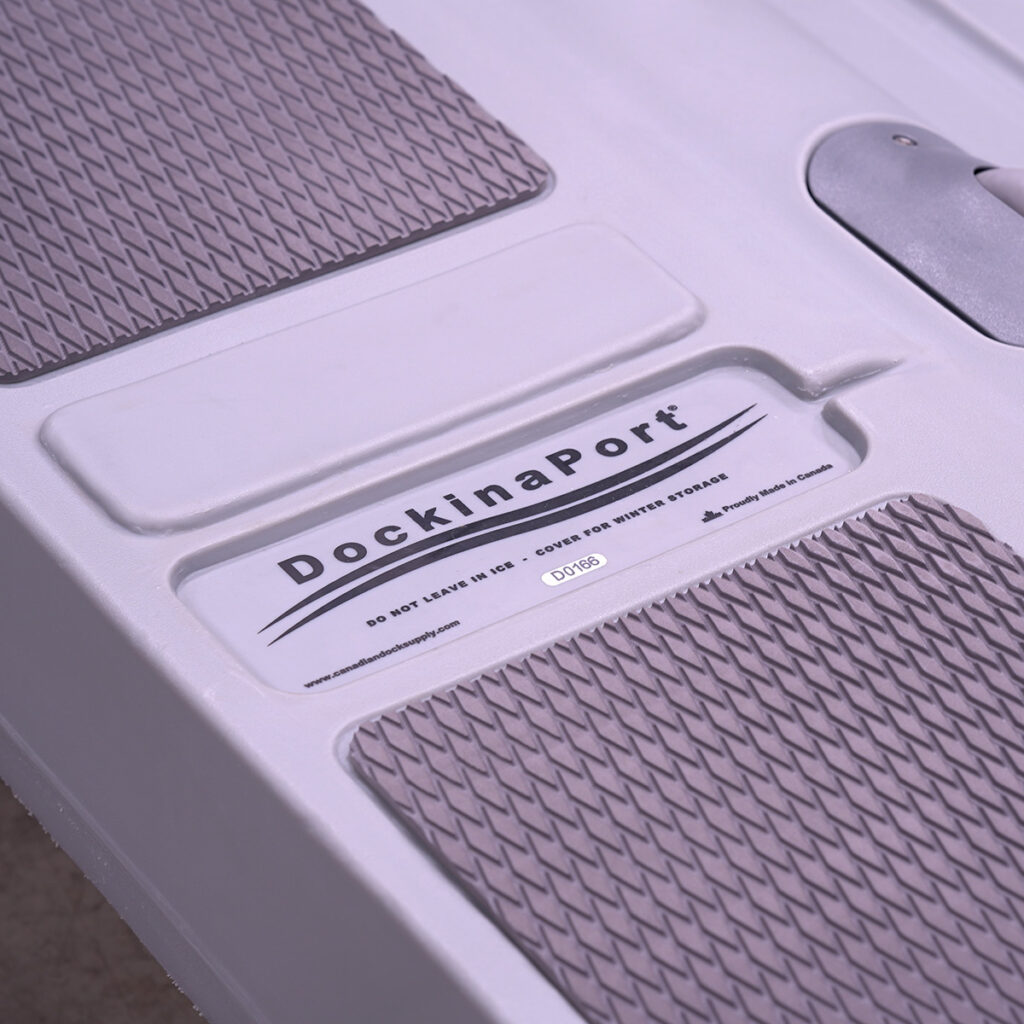
Popular Options:
The Eva foam walkway mat is an option available for the DockinaPort®. This is very popular, and DockinaBox® is the only manufacturer to offer it. This is the same material you see on all premium paddle boards. It does not get hot and gives incredible grip.
Another option we feature is the dual brake mechanism. This is exclusive to the DockinaPort® and allows you to lock two wheels on the walkway side of the port. This has a few interesting benefits; if you are taking a break and don’t feel like locking up or tying the front bow eye on the watercraft to the front bow stop tie off ring, you can simply press down with your toe the lever to engage the brake on either the front or rear or both. This can also be used in a (front only on position) for those who may come in a bit fast with their PWC so the front wheel will skid on the bottom when the craft is almost up to the front. All ports are generally made to be used in calm water. Excessive wave conditions can damage the port, the mounts, or the dock it is attached to. It is good to know however if an occasional large wave comes in that you can adjust a few of the air chambers to tilt the port down at the front and apply the optional brakes to reduce the risk of your PWC rolling off.
Winterizing and care of your DockinaPort®
Winterizing your port is just a matter of removing it from the water and placing it on a flat surface. Covering the port is recommended to reduce contact with the elements. If the Eva foam matt is installed, the port should be covered like you would with your paddleboard. The quality, thickness and the UV stabilization used to manufacture this port will you give many years of use.
The port was designed without Styrofoam and has a military style gore vent to release excessive air pressure that can build up from outside temperature change. Styrofoam is undesirable, as it is an unrecyclable product and is being banned in many areas and can carry a surcharge for disposal.
Much like our floating docking systems, if over time condensation does build up in our DockinaPort® this water can be removed through a fitting located just above the waterline under the walkway. Because Styrofoam absorbs water, competitive docking systems will absorb water and become heavier and unstable over time and eventually need to be discarded once they become too waterlogged. Unknown to many, once moisture gets in Styrofoam, you cannot get it out.
DockinaBox® is very environmentally conscious and we are trying to do our part by not introducing unrecyclable products to the market in all the products we manufacture.

Contact DockinaBox®

